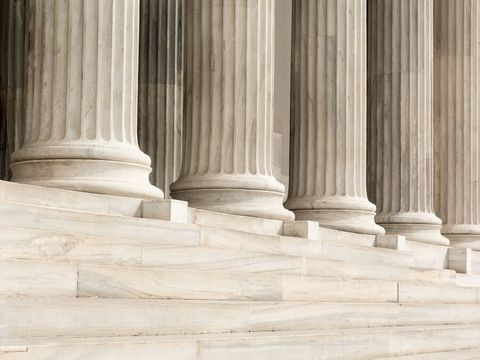Morgan vs Sundance: Enforceability of Arbitration Provisions
Client Alert | 3 min read | 06.03.22
On May 23, 2022, the Supreme Court of the United States ruled in a unanimous opinion in Morgan v. Sundance, No. 21-328 that the Federal Arbitration Act (“FAA”) serves to make arbitration agreements as enforceable as other contracts; it does not permit the courts to “devise novel procedural rules” to foster arbitration. Specifically, prior to this ruling, almost all federal circuits used an arbitration-specific waiver rule requiring a showing of prejudice to one party in order to demonstrate that the opposing party waived its right to compel arbitration. Under this new ruling, a party seeking to demonstrate that the opposing party waived its right to compel arbitration by litigating for too long need not make a showing that it was prejudiced, which is consistent with federal waiver law.
Petitioner Robyn Morgan was an hourly employee at a Taco Bell franchise owned by Sundance, the respondent. Morgan signed an agreement to use confidential binding arbitration to resolve any employment dispute; however, she brought a nationwide collective action against Sundance in federal court alleging that the company’s calculation of overtime violated the Fair Labor Standards Act. Instead of immediately moving to compel arbitration under the agreement, Sundance first began to defend itself, filing a motion to dismiss and, once denied, answering Morgan’s complaint, and attending a mediation. When Morgan’s lawsuit did not settle, Sundance moved to stay the litigation and compel arbitration. Morgan opposed, arguing that Sundance waived its right to arbitrate by litigating the matter for eight months. The District Court denied Sundance’s motion, but the Court of Appeals reversed, sending the matter to arbitration.
The lower courts applied the following Eighth Circuit test to decide whether Sundance waived arbitration: a party waives its contractual right to arbitration if it (1) knew of the right, (2) acted inconsistently with the right,and (3) prejudiced the other party by its inconsistent actions. A demonstration of prejudice is not otherwise required under federal waiver law.
The Supreme Court held that the courts may not create “arbitration-specific variants of federal procedural rules,” despite the FAA’s “policy favoring arbitration.” Outside of the arbitration context, a federal court assessing waiver (of a contractual right, or of any other) focuses on the actions of the person who held the right, rarely considering the effects of the actions on the opposing party. The arbitration-specific rule in the Eighth Circuit, amongst eight other circuits, was derived from an old Second Circuit decision identifying an “overriding federal policy favoring arbitration” and holding that a “mere delay” in seeking a stay of litigation without some resulting prejudice to the opposing party “cannot carry the day.” Based on that holding, most federal courts (aside from the D.C. and Seventh Circuits) have justified the prejudice requirement.
The Supreme Court ended this decades-old trend in Morgan, holding that the FAA’s policy favoring arbitration does not authorize invention of a factor that does not otherwise exist in the federal procedural rules, and emphasizing that arbitration agreements are to be held on equal footing with other kinds of contracts. The matter will now be remanded to the Eighth Circuit Court of Appeals, where the court must determine which rules govern when a defendant waits to invoke a contractual right, and how those rules will be applied to Sundance’s delay.
In light of this decision, parties seeking to enforce an arbitration provision should move to do so sooner rather than later in order to mitigate the risk that they waived that right.
Contacts
Insights
Client Alert | 5 min read | 12.12.25
Eleventh Circuit Hears Argument on False Claims Act Qui Tam Constitutionality
On the morning of December 12, 2025, the Eleventh Circuit heard argument in United States ex rel. Zafirov v. Florida Medical Associates, LLC, et al., No. 24-13581 (11th Cir. 2025). This case concerns the constitutionality of the False Claims Act (FCA) qui tam provisions and a groundbreaking September 2024 opinion in which the United States District Court for the Middle District of Florida held that the FCA’s qui tam provisions were unconstitutional under Article II. See United States ex rel. Zafirov v. Fla. Med. Assocs., LLC, 751 F. Supp. 3d 1293 (M.D. Fla. 2024). That decision, penned by District Judge Kathryn Kimball Mizelle, was the first success story for a legal theory that has been gaining steam ever since Justices Thomas, Barrett, and Kavanaugh indicated they would be willing to consider arguments about the constitutionality of the qui tam provisions in U.S. ex rel. Polansky v. Exec. Health Res., 599 U.S. 419 (2023). In her opinion, Judge Mizelle held (1) qui tam relators are officers of the U.S. who must be appointed under the Appointments Clause; and (2) historical practice treating qui tam and similar relators as less than “officers” for constitutional purposes was not enough to save the qui tam provisions from the fundamental Article II infirmity the court identified. That ruling was appealed and, after full briefing, including by the government and a bevy of amici, the litigants stepped up to the plate this morning for oral argument.
Client Alert | 8 min read | 12.11.25
Director Squires Revamps the Workings of the U.S. Patent Office
Client Alert | 8 min read | 12.10.25
Creativity You Can Use: CJEU Clarifies Copyright for Applied Art
Client Alert | 4 min read | 12.10.25
Federal Court Strikes Down Interior Order Suspending Wind Energy Development





